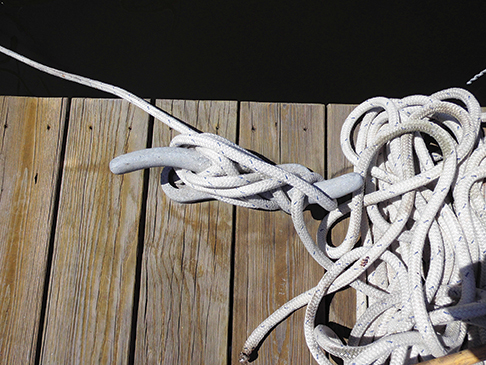Keeping the marital knot tied (published August 2015)
From time to time Jill and I (okay, mostly Jill) are asked by other sailing couples (okay, mostly the women) about getting along on their boats (okay, mostly about the tyrannical behavior of the men). We reflect on our own experiences and offer back what we hope is harmonizing advice.
Today’s inquiry was from the Venus side of a very-well educated, professional couple with a long-standing relationship and marriage. It read not unlike a Dear Abby letter: “Dear Jill, I need your advice. Hubby insists that we tie all our knots the same way. ‘Use the right knot in the right place—it’s a safety thing’, he says. I like how I hang fenders and he insists I change. Should I hold my ground? What do you and Pete do?”
It was a few minutes before Jill stopped laughing with “been there done that stories” and we had a “serious” discussion on this “critical” marital dispute. Let’s put this into perspective. Some boats sport placards that read, “Sailing is not a life or death matter. It is more serious than that.” Long ago Jill and I decided that placard was missing a final phrase, “but not as serious and important as your marriage”. In the chronology of our successful sailing relationship, this realization came somewhere between “yelling does not help” and “don’t mumble—talk loud but sweetly”. Do knots matter? Sure they do. But as with most things, there are degrees. Total rigidity rarely is necessary (but good anchor holding also helps assure marital bliss).
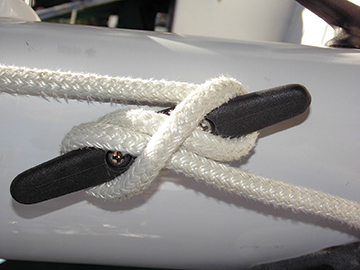
What is a knot anyway? A knot has three immutable characteristics: 1) It is easy to tie, 2) It is strong and holds, and 3) It is easy to untie. Everything else is a nothing more than a tangle. Number two above also aptly describes a good marriage.
Back to our inquiring writer. We first must praise this couple for actually tying knots instead of resorting to the endless host of chandlery products offered to “make hanging and adjusting fenders easy”. The fact that they are tying knots and discussing them is a good sign for their future sailing together.
For years we have kept five foot long lengths of 3/8” line in multiple rooms of our house for practicing knot tying. Several knot tying books are found on our boat. I even once made a knot board with some 75 different knots and bends just to prove I could tie all those knots. In the end Jill and I decided we could sail the world with just a cleat hitch, four knots (square knot, bowline, rolling hitch, and clove hitch or half hitch/double half hitch), and one related best practice: gasketing a coil of line.
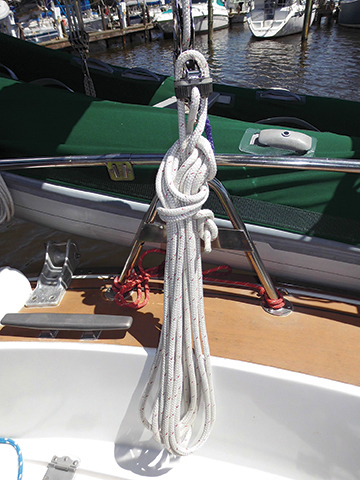
WHERE IT REALLY MATTERS
On our boat, the one knot-related practice applied with some rigidity is how we gasket any coils of line. When things get nasty (sea state that is) is not the time to have to figure out how to get a coil of line running free in order to drop a sail quickly. Less stressful, but oft repeated, is the storing and uncoiling of dock lines. Gasketed well, the coil is easy to hang, does not come undone, and releases without tangling. There are a few different methods to gasket a line. Just pick one and use it consistently.
MORE IS NOT BETTER
The cleat hitch is elegance in its simplicity. Extra turns, twirls, and embellishments are unnecessary, do not make the knot any stronger or more secure, and just scream out, “not tied by a seaman, ummm, seaperson”. A walk down most docks will reveal any number of examples of cleat messes that are clearly not easy to untie.
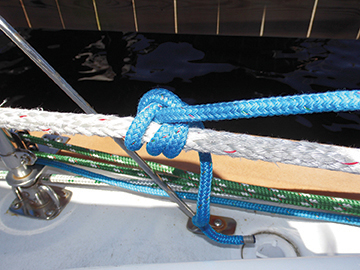
THIS KNOT COULD SAVE YOUR DAY OR YOUR HAND
The rolling hitch is the vice-grip of knots. It can grab another line tightly but can be slid easily when not under tension. We secure our halyards away from the masts with this knot. Just this weekend we lowered and raised our roller furler with a rolling hitch of light line tied around it (and a bowline on the other end going to the halyard shackle). But the one use of a rolling hitch that every sailor should learn is the releasing of a sheet jammed on a winch, which could also involve a pinched finger or hand. For this purpose a few yards of 3/8” double braid line should live in your cockpit in a coaming box or hanging on the mizzen mast. This lighter line is tied around the taut end of the sheet a foot or more ahead of the winch, using a rolling hitch, with the double turns closest to the winch. The other end of the line goes to another winch to pull in the sheet and release its tension from the winch where the sheet is stuck. With practice you can release the line faster than you could cut through it. Winch overrides happen at the most inconvenient of times. Cutting a sheet can really ruin your day and there is no excuse for cutting one because you now know how to release its tension quickly.
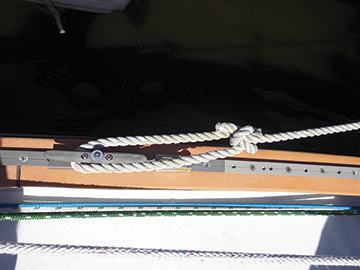
NO RABBITS WERE HARMED IN THE MAKING OF THIS KNOT
As to our four “necessary” knots, the bowline is perhaps the one most used, but alas probably the one least applicable for hanging fenders. Most learn to tie a bowline around themselves or a fixed object (drawer handles are popular). In the real world one has to be able to tie the bowline as a free-standing loop, through a ring, or around an object while standing, kneeling, balancing, or hanging in all sorts of contorted positions. At those times the rabbit does not always want to come out of the hole, go around the tree, and back into the hole. This is where practice with that five-foot scrap of line comes in. Eventually muscle memory is developed and rabbits need no longer be recruited during the tying of your bowlines.
The simple bowline also is the basis of a bowline in a bight, a water bowline (best when towed through the water), and a triple bowline (with a double or triple loops to improve wear). Consider these as optional or elegant variations. They look enough like the basic bowline that they will always be familiar to your spouse when it comes time to untie them, but not mandatory for both of you to be able to tie.
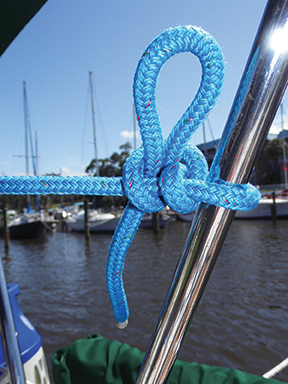
TYING FAST
Knots that secure a line to, not just around, a piling, stanchion, or lifeline are called bends. A turn of the line around the post followed by two half hitches (known to non-sailors as just “knots”), tied in the same direction, is the simplest form of secure bend, a double half hitch. This knot can also be tied with the tail folded over in the second hitch making it quick to release by pulling the tail. A clove hitch is another favored bend we use often, but it would be hard for me to declare one as better than the other except that the clove hitch has two rounds of line around the piling. The clove hitch can be made instantly by laying two loops over the top of a piling. There are plenty of YouTube demonstrations of this “magic” method. There is no shame in adding an extra half hitch of the tail around the working end of a clove hitch. Sending a hammer aloft to forgetful hubby hanging in a bosun’s chair calls for a bend around the handle right under the hammer’s head (although a tool bag tied on with a bowline works well, too). And all of these bends would work for hanging a fender.

Tying a line to itself, around something like a boom, calls for a square knot. A common example is gasket lines holding a reefed sail to the boom (but with stack packs and lazy jacks does anyone still do this?) or a line tied around a parts box to keep it closed. Here again variations are useful. Folding over the tail of the last wrap leaves the tail in a quick-release mode making the knot very convenient, dare I say for hanging fenders? Several extra twists turn a square knot into a surgeon’s knot which holds in slippery monofilament fishing line.
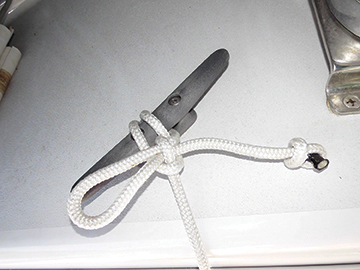
AND A BONUS KNOT
We also have one “bonus” knot that amazes and entertains children and innocent bystanders: the quick release or “dinghy knot”. This knot holds the dinghy painter fast to the dock or boat. Pulling the tail instantly releases the line from the piling or cleat. There are a few different ways to tie a dinghy knot (https://www.youtube.com/watch?v=gx6Sof1ZWSY). Jill and I use different approaches, but that doesn’t matter since the evidence vanishes regardless of who pulls the tail. This knot also works great for, you guessed it, hanging fenders.
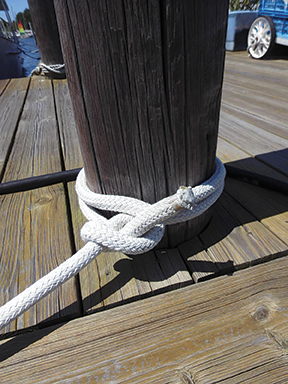
HAPPILY EVER AFTER
To our writer we say, “Master the rolling hitch, agree how you will gasket coils of line on your boat, and tie your fenders using a knot familiar to both you and your sailing partner: clove hitch, double half hitch, or one of the variety of quick release knots and get on with the serious stuff of sailing—loving to sail together”.
For over a decade now, Pete Dubler has been writing for BWS about projects on his Pearson 424 including articles in this series detailing her complete restoration and refit. During 2015, under a phased retirement program, Pete and his wife Jill will spend more time shaking out S/V Regina Oceani and plan to depart for worldwide cruising December 2015.















